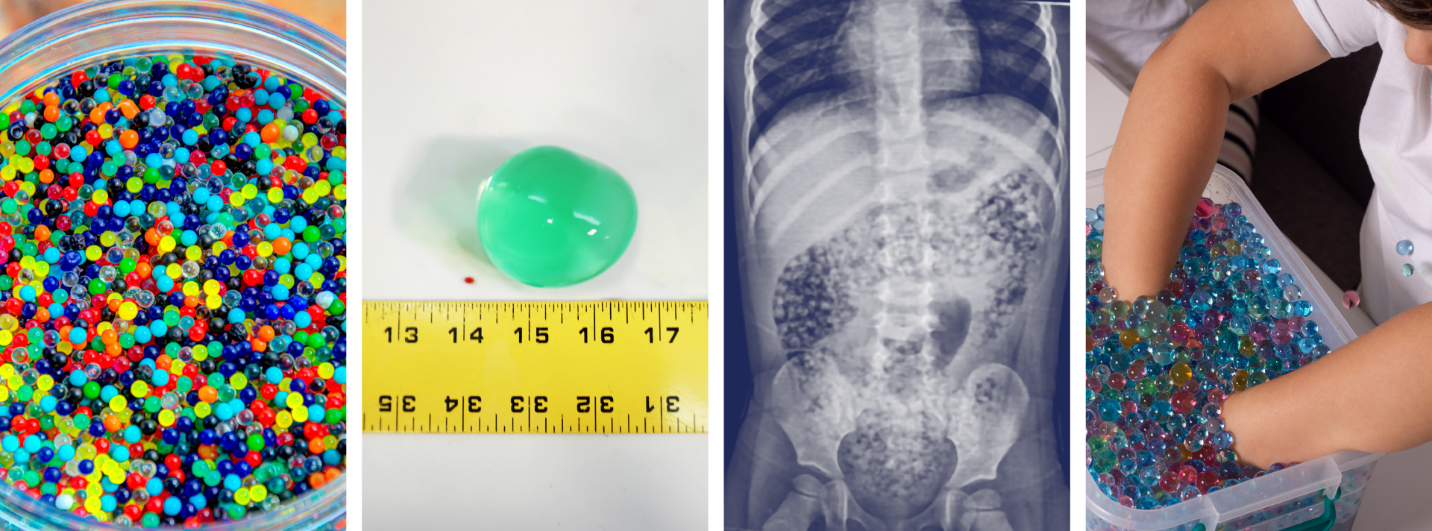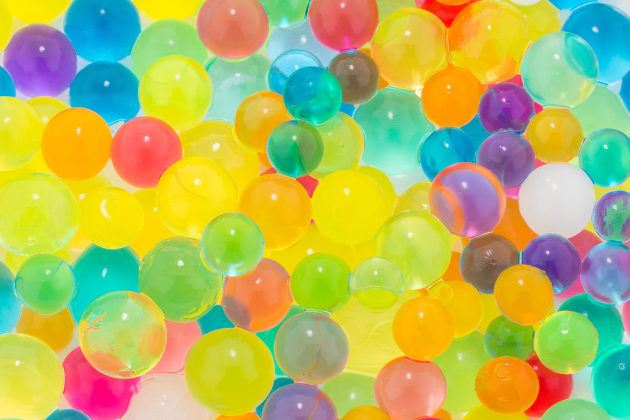A safety-related blog post to promote awareness: Fidget toys made with water beads have become popular, but they pose significant dangers. We are spreading the word amongst our Risking Connection® organizations participating in the Traumatic Stress Institute Whole System Change Model with the hope they can share and help protect their staff, the clients and families they serve, as well as their wider communities.
The Danger
Water beads (also known as jelly beads, hydro orbs, and gel beads) have become popular in recent years and are often used in sensory toys and fidget gadgets for children and adults but are dangerous for young children and pets if swallowed – especially for children three years and younger. They are appealing to young children because they are colorful, small, and they look like candy. Children may attempt to eat them, put them in their ears or nose, or try to feed them to their pets.
There are numerous toys that use water beads. They are often marketed as either children’s toys or therapies for children with sensory processing or autism spectrum disorders. Some brands of toy water beads for children include Orbeez®, MarvelBeads® and Elongdi®.
In addition to children’s toys, water beads are also sold as:
- arts and crafts supplies
- vase fillers for florists
- ammunition (sometimes frozen) for “gel blaster” guns (a cross between paintball gun and airsoft gun)
The National Capital Poison Center warned that “Water beads contain superabsorbent polymers that can expand to hundreds of times their original size, after exposure to water or other fluids. These beads, which are often sold as toys for young children, can cause life-threatening intestinal blockage if swallowed.”

Photo credit: Consumer Product Safety Commission (CPSC ) website
The U. S. Consumer Product Safety Commission (CPSC) reported in a September safety alert that the beads, which often can’t be seen on x-rays because they’re mostly made of water, “can cause severe discomfort, vomiting, dehydration, intestinal blockages and life-threatening injuries." They added an additional warning this month that –contrary to often being labeled as non-toxic – some of these products contain acrylamide, a likely carcinogen and neurotoxin. Consumer Reports’ own lab tests had also revealed that some brands contain BPA.
After numerous life-threatening injuries and hospital visits, a bill entitled the Ban Water Beads Act, HR-6468 was introduced into Congress in November of 2023, but it has yet to move forward. When the bill was introduced, Consumer Reports got behind it. Consumer Reports Associate Director of Safety Policy, William Wallace, said to CNN, “Water beads are a nightmare for parents: they look harmless and fun, but they can be deadly. Yet companies are marketing them as safe, leading parents to unknowingly put their children at risk.” The bill would label certain water beads products as hazardous, specifically ones marketed or made for children.
Consumer Reports (CR) announced that amid mounting pressure, Amazon, Walmart, and Target, and some other stores have changed their policies on water beads. As of January 2024, the companies stated they will no longer allow the products to be sold if they are being marketed for children. Unfortunately, at the time of this posting Amazon, Target, and Walmart all still have water bead products listed on their websites under their “toy” sections. These companies are aware of the danger of these products and are beginning to make concerted efforts to remove them from their inventory, but change can't come fast enough. According to their report, "CR’s safety experts continue to urge parents not to buy these products while the companies implement their new policies.”
What You Can Do About It
Family serving organizations, programs, parents, caregivers and others can do the following to eliminate potential harm from fidget toys and gadgets made with water beads:
- Throw away all toys that have water beads in them, securing them first so that no one else can get at them
- Please do not donate these toys
- Share this information with others
- Do not purchase these items for your programs
- Avoid use of water beads in non-toy applications, especially when young children may be able to access them
- Use this recall list to be an informed consumer: https://www.cpsc.gov/Recalls
In Case of Emergency
- Call the National Poison Help Line at 800-222-1222. Available 24/7.
Contact the Traumatic Stress Institute if you have any questions, concerns, or need guidance.
References (in addition to the links supplied above):
- https://www.healthychildren.org/English/safety-prevention/at-home/Pages/Water-Beads-Harmful.aspx
- Horie; M. Báron; R. B. Fox; J. He; M. Hess; J. Kahovec; T. Kitayama; P. Kubisa; E. Maréchal; W. Mormann; R. F. T. Stepto; D. Tabak; J. Vohlídal; E. S. Wilks & W. J. Work (2004). "Definitions of terms relating to reactions of polymers and to functional polymeric materials (IUPAC Recommendations 2003)"(PDF). Pure and Applied Chemistry. 76 (4): 889–906. doi: 10.1351/pac200476040889. S2CID 98351038.
- Buchholz, Fredric L; Graham, Andrew T, eds. (1997). Modern Superabsorbent Polymer Technology (1 ed.). John Wiley & Sons. ISBN978-0-471-19411-8.


